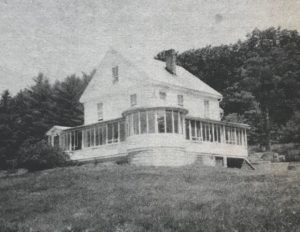Blog
How Devens Lost Its Cows and Ayer Police Became Cowboys
Tom May, historian associated with the earlier Fort Devens museum, was a great storyteller. One tale he relished telling was “the first and only cattle drive in the history of the neighboring town of Ayer.”
May’s story appeared in print in the July 19, 1973, edition of the fort’s newspaper, The Fort Devens Dispatch. The incident itself dated back to May 18, 1932. The “cattle drive” took place because of what farmer Carl Dickinson set in motion back at the period following World War I when he struck a verbal agreement with the federal government as the Army was purchasing the land previously leased in 1917 from landowners like Dickinson upon which it built Camp Devens.
He wished to remain on the farm where he had lived since 1879 in the section of town of Harvard land taken for the cantonment. To secure continued rights to have his cattle graze about his farm, he said he’d not object if artillery shells might pass over the farm on their way to some distant target. Since the base had been placed in caretaker status following the war, Dickinson and his herd had it easy. In addition to no artillery firing, only a small caretaker force maintained the post, except for youth groups coming in for a month each summer to taste military life. During the entire decade of the 1920s, the cows had free run of the grasslands without challenge — not only within the farm but further afield.
All that changed when Camp Devens became Fort Devens in 1931. In came elements of the 13th Infantry Regiment as well as of the 66th infantry Regiment (Light Tanks). Training required movement about the entire post all year around. Inevitably units on maneuvers in the field were bothered by cows, and tanks had to swerve to avoid hitting bovine creatures. The first commander of Fort Devens, Col. Albert Foreman, had to warn Dickinson to keep his cows from straying off the farm.
Over time, relations between the Army’s soldiers and Dickinson’s cows must have frayed. The breakdown of their coexistence came when Dickinson’s water well reached such a low level that not enough water was available for the herd. On the fateful May day, a hired hand drove 45 cows to the Nashua River, located at some distance from the farm.
Low and behold, a captain, a sergeant, and a private (not named by May) stood on the river bank to stop this effort to reach water. Threatening to confiscate the cattle, the captain ordered the sergeant and private to drive the herd toward the fort’s main gate, a couple of miles away. Colonel Foreman telephoned Ayer selectmen to warn them the cattle would be left for the town’s field driver to contend with at the entrance to the fort.
As the cows exited the main gate they at first milled about aimlessly on the town’s West Main Street. Instead of one town official, Ayer police responded in force and began coaxing the herd to move toward the town pound. At the time this lock-up for animals was located on upper Washington Street, which meant conducting the cattle along a portion of Main Street and getting them to turn left onto Washington Street for the uphill trek to the pound.
Word reached Main Street of the cattle drive about to descend upon the center of Ayer. A very large group of spectators gathered. As the “cowboys” in blue worked to keep cows off sidewalks and aimed into the proper turn, some in the crowd offered encouragement, others a bit of cutting humor. Eventually the drovers were successful in impounding the herd. What a spectacle the entire event must have been!
Surprisingly, Dickinson, according to May, never did come to claim his cows. In due time town authorities sold the herd. At a price of $18.75 per cow, the sale brought in a total of $581.25. The town kept $258, considered a fair amount “for caring for and feeding the cattle for 22 days.”
May concluded his story citing a “mystery”: Although 45 cows had been directed out of the fort, the tally of the number of cattle reaching the pound came to but 31 cows. No one seemed to know, or admit what happened to the other 14.
One mystery May does not address is what became of Dickinson.
May did add an interesting footnote to his story. Evidently Dickinson’s farmhouse on Devens land was utilized by the Army, while the outbuildings were demolished. Located on what may have been a far southeastern section of main post, the house, eventually torn down, overlooked Route 2 from a spot downhill from the future Salerno Housing Area. For some time this house served as home for one noncommissioned officer after another with an especially large family. May included a photo of this home. Too bad that no one evidently took pictures of the cattle drive.
C. David Gordon






